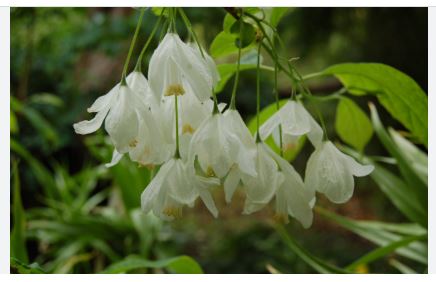
The Snowdrop Tree, also known as Two-Winged Silverbell or American Snowdrop Tree, is a species in the family Styracaceae, native to the southeastern United States from West Florida to eastern Texas to South Carolina particularly in regions with moist, well-drained soils such as riverbanks, floodplains, and lowland forests.
The genus name honors Stephen Hales (1677–1761), an English clergyman, inventor, physiologist and botanist. The species epithet means “two wings” and describes the two prominent wings of the fruits. The only other species in the genus, the Carolina silverbell, has four wings on its fruits. This tree is cultivated as an ornamental tree and contributes to native ecosystems by providing nectar for pollinators and small fruits for wildlife.
Characteristics
- Snowdrop trees are small to medium-sized, growing 20–30 feet tall, though some can reach up to 40 feet (12 meters). They have a spreading canopy that creates a rounded, graceful silhouette.
- The leaves are simple, ovate, and alternate, measuring 2–4 inches long. They are bright green in summer, turning yellow in autumn before dropping.
- The tree produces clusters of small, white, bell-shaped flowers in spring (March to May). These flowers resemble snowdrops, hence the common name. They are mildly fragrant and attract pollinators like bees and butterflies.
- After flowering, the tree develops distinctive winged, dry drupes about 1–2 inches long. These fruits are two-winged (hence the name diptera) and persist into winter.
- The bark is smooth and gray when young, becoming slightly furrowed with age, adding visual interest to the tree even in winter.
Cultivation
- The snowdrop tree thrives in USDA zones 5–9. It prefers mild climates with adequate rainfall but can tolerate moderate cold.
- It grows best in moist, well-drained, acidic soils. While it can tolerate a range of soil types, poorly drained or alkaline soils can hinder growth.
- The tree performs well in full sun to partial shade. In hotter climates, partial shade helps prevent stress from excessive heat.
- Regular watering is essential, particularly during dry spells and while the tree is establishing. Once mature, it is moderately drought-tolerant but prefers consistent soil moisture.
- Plant in early spring or fall, ensuring enough space for its canopy to spread. A spacing of 15–20 feet (4.5–6 meters) is recommended for proper air circulation.
- Minimal pruning is required, mainly to remove dead or damaged branches. Prune in late winter or early spring before new growth begins.
- Propagation is typically done via seeds, which require stratification (a cold period) to germinate. Softwood cuttings can also be used, though they are less common.
- The snowdrop tree is relatively pest-resistant but can occasionally face issues with aphids, scale insects, or leaf spots. Proper care and monitoring help prevent significant problems.
- The tree has a moderate growth rate, typically adding 12–18 inches (30–45 cm) in height per year under ideal conditions.
- This tree is often used as an ornamental plant in gardens and landscapes. It is suitable for rain gardens, shade gardens, and woodland settings2. The ‘Magniflora’ variety produces larger flowers and is more tolerant of drier conditions.
Species of Snowdrop tree
- Halesia diptera (Two-winged Silverbell): This species is distinguished by its two-winged fruit and white, bell-shaped flowers. It is native to the southeastern United States.
- Halesia carolina (Carolina Silverbell): Also known as Halesia tetraptera, this species has four-winged fruit and is native to the southeastern United States, from West Virginia and Kentucky south to Georgia and Alabama.
- Halesia monticola (Mountain Silverbell): Sometimes considered a variety of Halesia carolina, this species grows in the higher elevations of the Appalachian Mountains and has larger flowers and fruit.
- Halesia macgregorii (Taiwan Silverbell): Native to Taiwan, this species has similar bell-shaped flowers but is less commonly known and cultivated compared to its American relatives.
Two-wing silverbell has a better floral display than the Carolina silverbell (H. carolina), but it blooms one or two weeks later. Two-wing silverbell has low branches and can be grown either as a large, multi-stemmed shrub or trained as a single trunk tree. The two-wing silverbell is an attractive small tree for rain gardens or shade gardens.